Generator Replacement 2.2L
Removal Procedure
Caution: Unless directed otherwise, the ignition and start switch must be in the OFF or LOCK position, and all electrical loads must be OFF before servicing any electrical component. Disconnect the negative battery cable to prevent an electrical spark should a tool or equipment come in contact with an exposed electrical terminal. Failure to follow these precautions may result in personal injury and/or damage to the vehicle or its components.
- Disconnect the negative battery cable. Refer to Battery Negative Cable Disconnection and Connection .
- Remove the drive belt. Refer to Drive Belt Replacement in Engine Mechanical - 2.2L.
- Raise and support the vehicle. Refer to Lifting and Jacking the Vehicle in General Information.
- Working through the wheel well, remove the generator rear brace from the engine.
- Disconnect the generator electrical connector.
- Remove the generator output (BAT) terminal nut and wire.
- Remove the generator mounting bolts.
- Remove the generator from the vehicle.
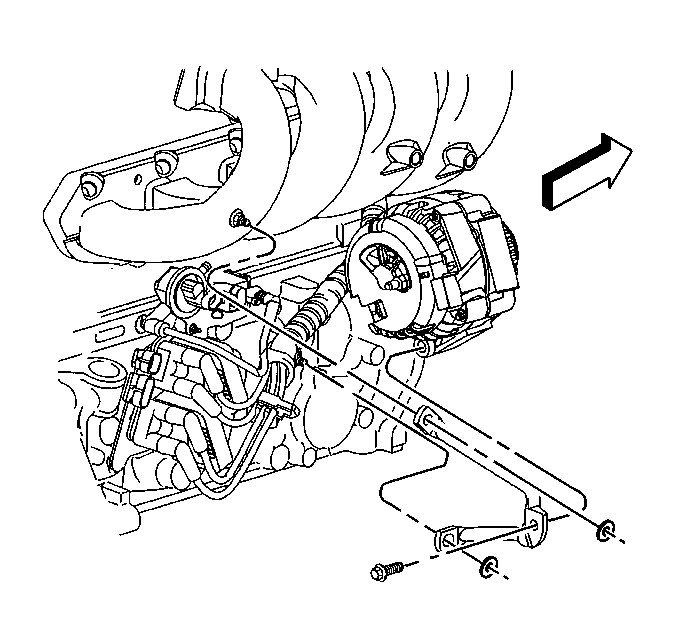
| • | Remove the generator brace to the engine block bolt. |
| • | Remove the generator brace to the intake manifold nut. |
| • | Remove the generator brace to the engine stud nut. |


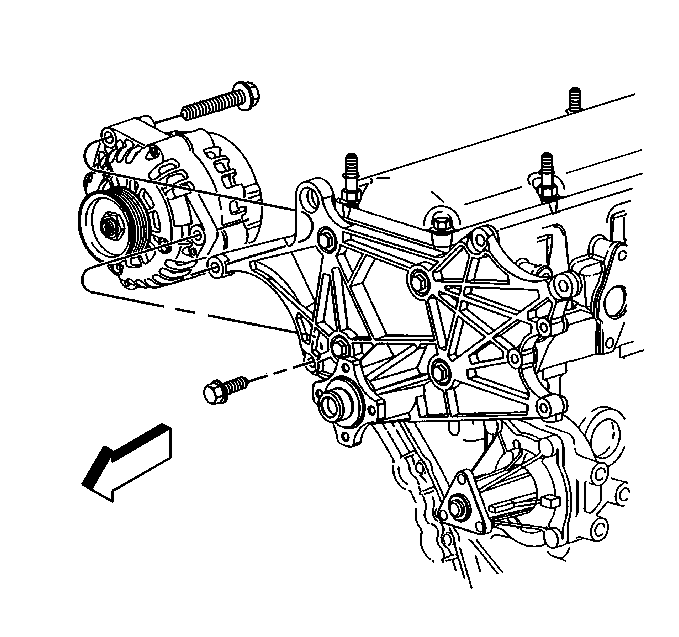
Installation Procedure
- Install the generator to the vehicle.
- Install the generator mounting bolts.
- Tighten the rear generator bolt to 50 N·m (37 lb ft).
- Tighten the front generator bolt to 25 N·m (18 lb ft).
- Install the generator output (BAT) terminal feed wire and retaining nut to the generator.
- Connect the electrical connector to the generator.
- Working through the wheel well, install the generator rear brace to the engine.
- Lower the vehicle.
- Install the drive belt. Refer to Drive Belt Replacement in Engine Mechanical - 2.2L.
- Connect the negative battery cable. Refer to Battery Negative Cable Disconnection and Connection .

Notice: Use the correct fastener in the correct location. Replacement fasteners must be the correct part number for that application. Fasteners requiring replacement or fasteners requiring the use of thread locking compound or sealant are identified in the service procedure. Do not use paints, lubricants, or corrosion inhibitors on fasteners or fastener joint surfaces unless specified. These coatings affect fastener torque and joint clamping force and may damage the fastener. Use the correct tightening sequence and specifications when installing fasteners in order to avoid damage to parts and systems.
Tighten

Tighten
Tighten the generator output (BAT) terminal nut to 17 N·m
(12 lb ft).


| • | Install the generator rear brace to the engine block bolt. |
| • | Install the generator rear brace to the intake manifold stud nut. |
| • | Install the generator rear brace to the engine stud nut. |
Tighten
| • | Tighten the generator rear brace to the generator bolt to 25 N·m (18 lb ft). |
| • | Tighten the generator rear brace to the air intake plenum stud nut to 25 N·m (18 lb ft). |
| • | Tighten the generator rear brace to the engine stud nut to 50 N·m (37 lb ft). |
Generator Replacement 4.3L
Removal Procedure
Caution: Unless directed otherwise, the ignition and start switch must be in the OFF or LOCK position, and all electrical loads must be OFF before servicing any electrical component. Disconnect the negative battery cable to prevent an electrical spark should a tool or equipment come in contact with an exposed electrical terminal. Failure to follow these precautions may result in personal injury and/or damage to the vehicle or its components.
- Disconnect the negative battery cable. Refer to Battery Negative Cable Disconnection and Connection .
- Remove the drive belt. Refer to Drive Belt Replacement in Engine Mechanical - 4.3L.
- Remove the heater hose brace bolt from the generator.
- Remove the generator mounting bolts.
- Remove the generator from the mounting bracket.
- Disconnect the generator electrical connector.
- Remove the generator output (BAT) terminal retaining nut from the generator.
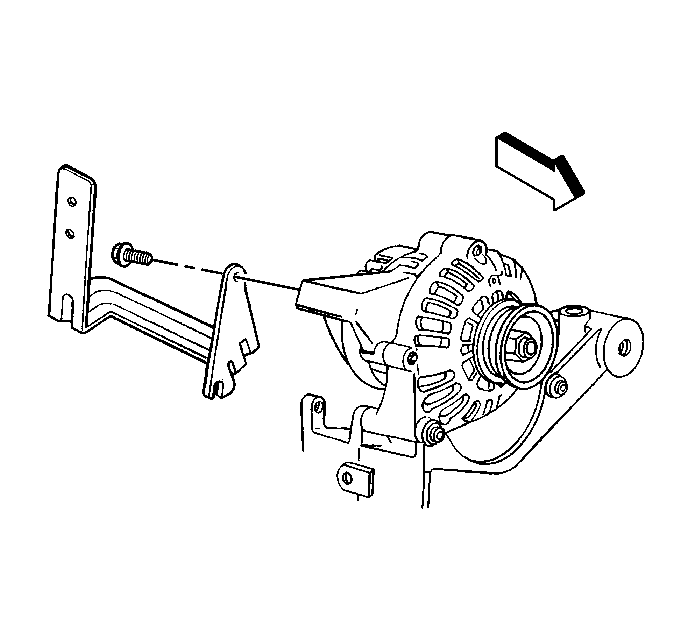
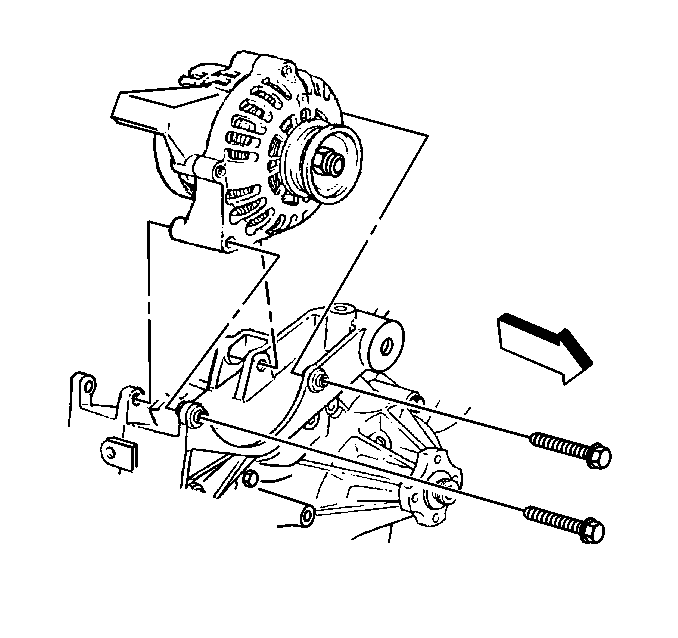

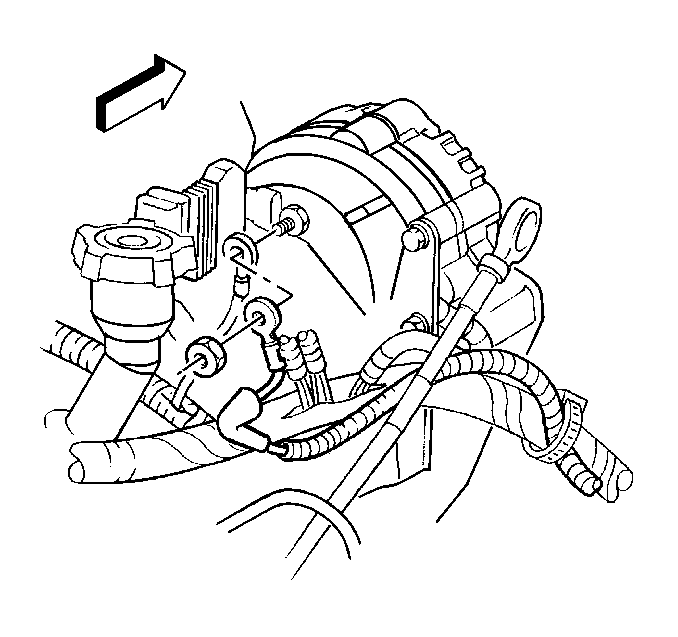
Installation Procedure
- Connect the generator output (BAT) terminal wire.
- Connect the generator electrical connector.
- Install the generator to the generator mounting bracket.
- Install the generator mounting bolts.
- Install the heater hose bracket bolt to the generator.
- Install the drive belt. Refer to Drive Belt Replacement in Engine Mechanical - 4.3L.
- Connect the negative battery cable. Refer to Battery Negative Cable Disconnection and Connection .

Notice: Use the correct fastener in the correct location. Replacement fasteners must be the correct part number for that application. Fasteners requiring replacement or fasteners requiring the use of thread locking compound or sealant are identified in the service procedure. Do not use paints, lubricants, or corrosion inhibitors on fasteners or fastener joint surfaces unless specified. These coatings affect fastener torque and joint clamping force and may damage the fastener. Use the correct tightening sequence and specifications when installing fasteners in order to avoid damage to parts and systems.
Ensure the insulating boot is covering the terminal nut.
Tighten
Tighten the generator output (BAT) terminal nut to 17 N·m
(12 lb ft).


Tighten
Tighten the generator mounting bolts to 50 N·m (37 lb ft).

Tighten
Tighten the heater hose bracket to the generator bolt to 25 N·m
(18 lb ft).
